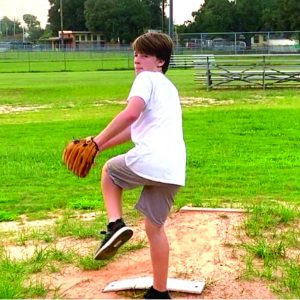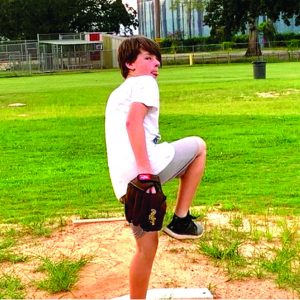 By Thomas T Wartelle WGTF Master Golf Teaching Professional Washington, Louisiana
The golf swing is a series of movements that takes a PGA Tour professional approximately 0.75 seconds for the backswing and 0.25 seconds
for the downswing, for a grand total of 1 second! The interesting thing is the 3:1 ratio of backswing to downswing. Studies have shown that the great players all had the similar 3:1 ratio. This certainly proves that timing and sequencing of the golf swing plays a big factor in long-term success. Interestingly, it has been found that most amateur golfers’ backswings are actually too slow and out of sequence to be consistently successful at impact.
Now, from a biomechanics standpoint, this is often caused by a backswing sequence that is just not as efficient as a tour player’s. A major
flaw often overlooked in amateur golfers is how the centers of their torso and pelvis move during the swing. The tour pro moves his centers slightly away from the target early in the backswing, like all athletic motions of throwing or swinging. This “early loading” occurs before the club shaft is parallel to the ground. It is typically only less than 1 inch. By the time a tour pro reaches the top of the backswing, their torso and pelvis re-center to their original position at address. One of the most interesting things is early in the downswing, their centers have moved ahead of the ball. This produces an optimal position to deliver an efficient and powerful impact.
High-handicap golfers tend to be much less efficient in their backswings. They do not do these sequences properly, or they do them too
late. Often, they continue to try to load away from the target late into the backswing. They feel like moving away from the target and trying
to maximize their turn creates more power. In reality, it just makes them later in getting their torso and pelvis centers into the proper downswing sequence. By trying to load too far and too late on the backswing, they end up working hard to try to “save” the shot. There is just not enough time on the downswing for them to deliver the club to a successful impact position.
Now, how do we relate this to instruction? Many instructors are using really great modern technology to pinpoint the flaws of a golf swing. Here is where instructors get it wrong: With all of their technology, pressure plates, launch monitors and metrics, they fail to convey the proper message to the student. Remember, the golf swing happens in a mere second from the move away until impact. Think about it: As a kid, did you analyze where your torso and pelvis centers were located when you tried to hit a baseball? Did you think about your weight distribution when you threw a ball? Did you think about your center of gravity when you started to jump?
Some people have more athletic awareness than others; however, most people have an innate ability to achieve some level of a golf swing goal. Granted, there can be some limitations, but mostly these innate abilities need to be activated or woken up. There are many thoughts and drills that one can use to achieve better swing sequencing. As an instructor, I try to use more active drills and feelings to achieve swing goals.
For example and thinking out of the box, there is my son, who is an up-and-coming junior golfer. He was not quite getting his swing sequencing where he wanted to be. I simply brought out a baseball and glove. As we began to throw, I encouraged him to throw harder and harder. The next time he hit balls, he instantly felt all of the swing sequencing described earlier. This positive result happened without rattling off metrics and going into a long biophysical explanation to the student. After all, golf is a results-oriented endeavor, and most students are looking for results.
As an instructor, I encourage the use of technology. But more importantly, learn how to apply the technology to help you convey the
message through active teaching. Technology is great, but not always really needed. A truly trained eye and analysis of the ball strike can discern most impact flaws. Technology only quantifies exact numbers. Students are generally not interested in the numbers and biomechanics. They are interested in hitting solid shots and playing better.
By Thomas T Wartelle WGTF Master Golf Teaching Professional Washington, Louisiana
The golf swing is a series of movements that takes a PGA Tour professional approximately 0.75 seconds for the backswing and 0.25 seconds
for the downswing, for a grand total of 1 second! The interesting thing is the 3:1 ratio of backswing to downswing. Studies have shown that the great players all had the similar 3:1 ratio. This certainly proves that timing and sequencing of the golf swing plays a big factor in long-term success. Interestingly, it has been found that most amateur golfers’ backswings are actually too slow and out of sequence to be consistently successful at impact.
Now, from a biomechanics standpoint, this is often caused by a backswing sequence that is just not as efficient as a tour player’s. A major
flaw often overlooked in amateur golfers is how the centers of their torso and pelvis move during the swing. The tour pro moves his centers slightly away from the target early in the backswing, like all athletic motions of throwing or swinging. This “early loading” occurs before the club shaft is parallel to the ground. It is typically only less than 1 inch. By the time a tour pro reaches the top of the backswing, their torso and pelvis re-center to their original position at address. One of the most interesting things is early in the downswing, their centers have moved ahead of the ball. This produces an optimal position to deliver an efficient and powerful impact.
High-handicap golfers tend to be much less efficient in their backswings. They do not do these sequences properly, or they do them too
late. Often, they continue to try to load away from the target late into the backswing. They feel like moving away from the target and trying
to maximize their turn creates more power. In reality, it just makes them later in getting their torso and pelvis centers into the proper downswing sequence. By trying to load too far and too late on the backswing, they end up working hard to try to “save” the shot. There is just not enough time on the downswing for them to deliver the club to a successful impact position.
Now, how do we relate this to instruction? Many instructors are using really great modern technology to pinpoint the flaws of a golf swing. Here is where instructors get it wrong: With all of their technology, pressure plates, launch monitors and metrics, they fail to convey the proper message to the student. Remember, the golf swing happens in a mere second from the move away until impact. Think about it: As a kid, did you analyze where your torso and pelvis centers were located when you tried to hit a baseball? Did you think about your weight distribution when you threw a ball? Did you think about your center of gravity when you started to jump?
Some people have more athletic awareness than others; however, most people have an innate ability to achieve some level of a golf swing goal. Granted, there can be some limitations, but mostly these innate abilities need to be activated or woken up. There are many thoughts and drills that one can use to achieve better swing sequencing. As an instructor, I try to use more active drills and feelings to achieve swing goals.
For example and thinking out of the box, there is my son, who is an up-and-coming junior golfer. He was not quite getting his swing sequencing where he wanted to be. I simply brought out a baseball and glove. As we began to throw, I encouraged him to throw harder and harder. The next time he hit balls, he instantly felt all of the swing sequencing described earlier. This positive result happened without rattling off metrics and going into a long biophysical explanation to the student. After all, golf is a results-oriented endeavor, and most students are looking for results.
As an instructor, I encourage the use of technology. But more importantly, learn how to apply the technology to help you convey the
message through active teaching. Technology is great, but not always really needed. A truly trained eye and analysis of the ball strike can discern most impact flaws. Technology only quantifies exact numbers. Students are generally not interested in the numbers and biomechanics. They are interested in hitting solid shots and playing better.
 Learn active drills and exercises that can help each student of yours reach their maximum potential. Keep informed and keep learning new
techniques. However, pay homage to the past, as nothing is really new in athletic motion. We just learn different ways to convey the message. I recently learned a new thing too: I need a better catcher’s mitt and protection from my son’s lefthanded fastball!
Learn active drills and exercises that can help each student of yours reach their maximum potential. Keep informed and keep learning new
techniques. However, pay homage to the past, as nothing is really new in athletic motion. We just learn different ways to convey the message. I recently learned a new thing too: I need a better catcher’s mitt and protection from my son’s lefthanded fastball!
Copyright © 2023 United States Golf Teachers Federation, All Rights Reserved
200 S. Indian River Drive, Suite #206, Fort Pierce, FL 34950
772-88-USGTF or 772-595-6490 - www.usgtf.com
200 S. Indian River Drive, Suite #206, Fort Pierce, FL 34950
772-88-USGTF or 772-595-6490 - www.usgtf.com
